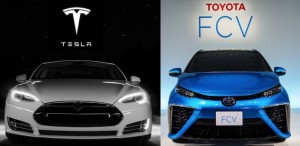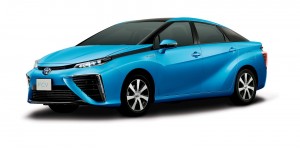 In case you’re in the market for a super-expensive, environmentally beneficial vehicle, Teslarati does a convenient side-by-side comparison of the Model S with the Toyota Mirai. The cars actually come out pretty even, with one glaring exception: the ease of fueling.
In case you’re in the market for a super-expensive, environmentally beneficial vehicle, Teslarati does a convenient side-by-side comparison of the Model S with the Toyota Mirai. The cars actually come out pretty even, with one glaring exception: the ease of fueling.
In our view, one of the major benefits of BEVs [battery electric vehicles] is that you refuel them at home, overnight, while you’re sleeping, so that your Model S is “full” every morning. Unless you travel long distances on a regular basis, you will rarely need a Tesla Supercharger or any other refueling source away from home. That’s huge, and often get’s lost in the discussion of “range anxiety” that always seems to invade the thinking of those who don’t own a Model S. Although fuel cells are sexy, it seems odd to us that Toyota has returned to a 20th century fueling station paradigm. In essence, there is little difference between refueling a Mirai and refueling a Camry. Sure, the fuel is different, but you have to hunt for a specific refueling station as your Mirai slowly depletes its hydrogen. No charging at home—ever.
Not to mention that the hydrogen can be energy-intensive to generate and may not come from clean sources. As I’ve written before, there are big question marks about the long-term environmental benefits of investing in hydrogen fueling. It may be necessary for some big cargo trucks that can’t otherwise be powered efficiently by batteries, but we shouldn’t look to it as a panacea for passenger vehicles.
Either way, we’ll need the prices on both vehicles to come down significantly in order to make a dent in our transportation emissions.
Toyota announced its new fuel cell vehicle, the Mirai. Available only in California, it has a range of up to 300 miles at $57,500 (not including rebates and tax credits), which also includes free hydrogen fueling for three years. The advantage? It can refuel in 5 minutes, compared to an hour or way more in a traditional battery electric vehicle.
The disadvantages? Well, if you like looks and horsepower, this vehicle won’t do it for you. One website review called it “crazy ugly” and noted it takes 9 seconds to accelerate to 62 miles per hour (compared to 4.1 seconds for the Tesla Model S).
The real disadvantage? The fueling infrastructure isn’t there. While battery electric drivers may complain about the lack of charging stations, at least electricity is ubiquitous and basically cheap. But with hydrogen, we need a whole new, expensive, and energy-intensive infrastructure to produce and dispatch the hydrogen.
Here’s Toyota’s response:
Research at the University of California Irvine’s Advanced Power and Energy Program (APEP) has found that 68 stations, located at the proper sites, could handle a FCV population of at least 10,000 vehicles. Those stations are on their way to becoming a reality. By the end of 2015, 3 of California’s 9 active hydrogen stations and 17 newly-constructed stations are scheduled to be opened to the general public, with 28 additional stations set to come online by the end of 2016, bringing the near-term total to 48 stations.
Nineteen of those 48 stations will be built by FirstElement Fuels, supported by a $7.3 million loan from Toyota. The company has also announced additional efforts to develop infrastructure in the country’s Northeast region. In 2016, Air Liquide, in collaboration with Toyota, is targeting construction of 12 stations in five states – New York, New Jersey, Massachusetts, Connecticut, and Rhode Island.
Personally, I think the expense and energy needs for the fuel disqualifies hydrogen fuel cells as a viable technology, at least for passenger vehicles. However, given that we need to electrify pretty much all of our transportation to meet our long-term greenhouse gas reduction goals, I could see hydrogen being useful (and maybe necessary) for heavy-duty shipping, as batteries may not be able to provide the power necessary.
In any event, we can see how Toyota and other fuel cell-committed companies like Honda do with their technologies. But from a public policy standpoint, we should not be subsidizing the fueling infrastructure for vehicles like the Mirai.



